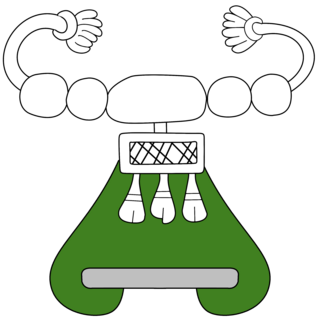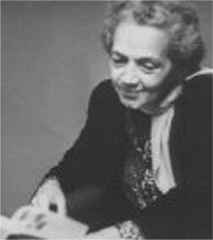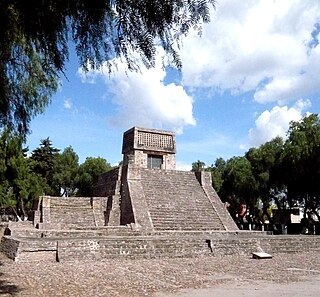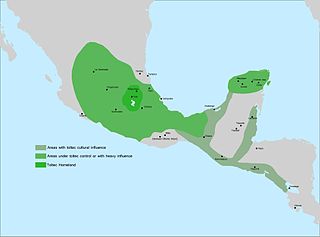Related Research Articles

The Toltec culture is a pre-Colombian Mesoamerican culture that ruled a state centered in Tula, Hidalgo, Mexico in the early post-classic period of Mesoamerican chronology. The later Aztec culture saw the Toltecs as their intellectual and cultural predecessors and described Toltec culture emanating from Tōllān[ˈtoːlːaːn] as the epitome of civilization; in the Nahuatl language the word Tōltēcatl[toːlˈteːkat͡ɬ] (singular) or Tōltēcah[toːlˈteːkaʔ] (plural) came to take on the meaning "artisan". The Aztec oral and pictographic tradition also described the history of the Toltec Empire, giving lists of rulers and their exploits.

Aztec mythology is the body or collection of myths of Aztec civilization of Central Mexico. The Aztecs were Nahuatl-speaking groups living in central Mexico and much of their mythology is similar to that of other Mesoamerican cultures. According to legend, the various groups who were to become the Aztecs arrived from the north into the Anahuac valley around Lake Texcoco. The location of this valley and lake of destination is clear – it is the heart of modern Mexico City – but little can be known with certainty about the origin of the Aztec. There are different accounts of their origin. In the myth the ancestors of the Mexica/Aztec came from a place in the north called Aztlan, the last of seven nahuatlacas to make the journey southward, hence their name "Azteca." Other accounts cite their origin in Chicomoztoc, "the place of the seven caves," or at Tamoanchan.

Tula de Allende is a town and one of the 84 municipalities of Hidalgo in central-eastern Mexico. The municipality covers an area of 305.8 km2 (118.07 sq mi), and as of 2010, the municipality had a total population of 103,919. The municipality includes numerous smaller outlying towns, the largest of which are El Llano, San Marcos, and San Miguel Vindho. It is a regional economic center and one of Mexico's fastest growing cities. However, it is best known as the home of the Tula archeological site, noted for its Atlantean figures. Its built-up area made up of Atotonilco de Tula, Atitalaquia, Tlaxcoapan municipalities was home to 188,659 inhabitants at the 2010 census.

Aztlán is the ancestral home of the Aztec peoples. Aztecah is the Nahuatl word for "people from Aztlan". Aztlan is mentioned in several ethnohistorical sources dating from the colonial period, and each of them give different lists of the different tribal groups who participated in the migration from Aztlan to central Mexico, but the Mexica who went on to found Mexico-Tenochtitlan are mentioned in all of the accounts. Historians have speculated about the possible location of Aztlan and tend to place it either in northwestern Mexico or the southwest US, although there are doubts about whether the place is purely mythical or represents a historical reality.

The Nahuas of El Salvador (Cuscatlan), better known as "Pipiles" in the academic literature, are an indigenous people who live in western El Salvador, which they call Cuscatlan. The Pipil language, or Nawat, belongs to the Nahuatl dialect group, which stretches from Durango in Mexico to El Salvador, and historically as far as the Nicoya Peninsula of Costa Rica. It is thought that the Pipil, along with the neighbouring Nicarao people, migrated from Central Mexico to their present location around 900 AD, after the Chichimeca-Toltec civil war. As they settled in the area, they founded the city-state of Cuscatlan, absorbed many other preexisting polities, and intermarried with the native peoples, mostly Lenca, Poqomam, and Xinca.
Tollan, Tolan, or Tolán is a name used for the capital cities of two empires of Pre-Columbian Mesoamerica; first for Teotihuacan, and later for the Toltec capital, Tula, both in Mexico. The name has also been applied to the Postclassic Mexican settlement Cholula.

Laurette Séjourné was a Mexican archeologist and ethnologist best known for her study of the civilizations of Teotihuacan and the Aztecs and her theories concerning the Mesoamerican culture hero, Quetzalcoatl.

Mesoamerican pyramids form a prominent part of ancient Mesoamerican architecture. Although similar in some ways to Egyptian pyramids, these New World structures have flat tops and stairs ascending their faces. The largest pyramid in the world by volume is the Great Pyramid of Cholula, in the east-central Mexican state of Puebla. The builders of certain classic Mesoamerican pyramids have decorated them copiously with stories about the Hero Twins, the feathered serpent Quetzalcoatl, Mesoamerican creation myths, ritualistic sacrifice, etc. written in the form of hieroglyphs on the rises of the steps of the pyramids, on the walls, and on the sculptures contained within.
Huematzin is mentioned in some Mesoamerican codices as being a sage and a member of Toltec nobility and scholar who lived during the end of the 8th century. It is unknown whether he was an actual historical person or a legendary figure. According to the Aztec chronicles he was the wisest man in Tollan, city of the Toltecs which may or may not be identical with the archeological site of Tula, and he owned many sacred books.

The Aztec religion originated from the indigenous Aztecs of central Mexico. Like other Mesoamerican religions, it also has practices such as human sacrifice in connection with many religious festivals which are in the Aztec calendar. This polytheistic religion has many gods and goddesses; the Aztecs would often incorporate deities that were borrowed from other geographic regions and peoples into their own religious practices.
Toltecayotl is a Nahuatl word derived from "tōltēcātl" which as used by the Nahuas to refer to the members of the Toltec civilization that preceded them in the basin of Mexico, as well as a generalized meaning of "artisan".

The Tepanecs or Tepaneca are a Mesoamerican people who arrived in the Valley of Mexico in the late 12th or early 13th centuries. The Tepanec were a sister culture of the Aztecs as well as the Acolhua and others—these tribes spoke the Nahuatl language and shared the same general pantheon, with local and tribal variations.
Culhuacan was one of the Nahuatl-speaking pre-Columbian city-states of the Valley of Mexico. According to tradition, Culhuacan was founded by the Toltecs under Mixcoatl and was the first Toltec city. The Nahuatl speakers agreed that Culhuacán was the first city to give its rulers the title of "speaker" (tlatoani).

The traditions of indigenous Mesoamerican literature extend back to the oldest-attested forms of early writing in the Mesoamerican region, which date from around the mid-1st millennium BCE. Many of the pre-Columbian cultures of Mesoamerica are known to have been literate societies, who produced a number of Mesoamerican writing systems of varying degrees of complexity and completeness. Mesoamerican writing systems arose independently from other writing systems in the world, and their development represents one of the very few such origins in the history of writing. The conquistadors brought their distinctive cultural creations, in the form of books, from Europe to the New World which further influenced native literature.

Quetzalcoatl is a deity in Aztec culture and literature whose name comes from the Nahuatl language and means "Precious serpent" or "Quetzal-feathered Serpent". In the 17th century, Ixtlilxóchitl, a descendant of Aztec royalty and historian of the Nahua people, wrote, "Quetzalcoatl, in its literal sense, means 'serpent of precious feathers', but in the allegorical sense, 'wisest of men'."

Cē Ācatl Topiltzin Quetzalcoatl is a mythologised figure appearing in 16th-century accounts of Nahua historical traditions, where he is identified as a ruler in the 10th century of the Toltecs— by Aztec tradition their predecessors who had political control of the Valley of Mexico and surrounding region several centuries before the Aztecs themselves arrived on the scene.

Atlantean figures are carved stone support columns or pillars in the shape of fierce men in Pre-Columbian Mesoamerica. These figures are considered to be "massive statues of Toltec warriors". They take their name from the European tradition of similar Atlas or Atalante figures in classical architecture, which was then revived in the Renaissance and especially popular in Baroque architecture. Atlantean here refers to the figures' supporting posture, alluding to the load-bearing Titan Atlas, not Atlantis.

Tula is a Mesoamerican archeological site, which was an important regional center which reached its height as the capital of the Toltec Empire between the fall of Teotihuacan and the rise of Tenochtitlan. It has not been well studied in comparison to these other two sites, and disputes remain as to its political system, area of influence and its relations with contemporary Mesoamerican cities, especially with Chichen Itza. The site is located in the city of Tula de Allende in the Tula Valley, in what is now the southwest of the Mexican state of Hidalgo, northwest of Mexico City. The archeological site consists of a museum, remains of an earlier settlement called Tula Chico as well as the main ceremonial site called Tula Grande. The main attraction is the Pyramid of Quetzalcoatl, which is topped by four 4-metre-high (13 ft) basalt columns carved in the shape of Toltec warriors. Tula fell around 1150, but it had significant influence in the following Aztec Empire, with its history written about heavily in myth. The feathered serpent god Quetzalcoatl is linked to this city, whose worship was widespread from central Mexico to Central America at the time the Spanish arrived.

The Mezquital Valley is a series of small valleys and flat areas located in Central Mexico, about 60 kilometres (37 mi) north of Mexico City, located in the western part of the state of Hidalgo. It is part of the Trans-Mexican Volcanic Belt, with altitudes between 1,700 metres (5,600 ft) and 2,100 metres (6,900 ft) above sea level. It is one of Mexico's main semi-arid/area regions, whose native vegetation is dominated by cactus species, mesquite trees, and maguey with pine and oak trees in the highest elevations. It is considered to be part of the northern extension of Mesoamerica, with one major archeological site, Tula, which was the main city of the Toltecs, an important influence for the later Aztecs. However, from the Aztec period to the 20th century, it was sparsely populated and very poor, with one main indigenous ethnicity, the Otomis. In the 20th century, irrigation works were created to take advantage of the water in the Tula River, along with wastewater drained from the Valley of Mexico for agriculture. Today the valley produces various grains and produce, including one-quarter of all green chili peppers grown in Mexico.

According to Mesoamerican historiography, the Toltec Empire, Toltec Kingdom or Altepetl Tollan was a political entity in modern Mexico. It existed through the classic and post-classic periods of Mesoamerican chronology, but gained most of its power in the post-classic. During this time its sphere of influence reached as far away as the Yucatan Peninsula.
References
- Andrews, J. Richard (2003) [1975]. Introduction to Classical Nahuatl (Revised ed.). Norman: University of Oklahoma Press.